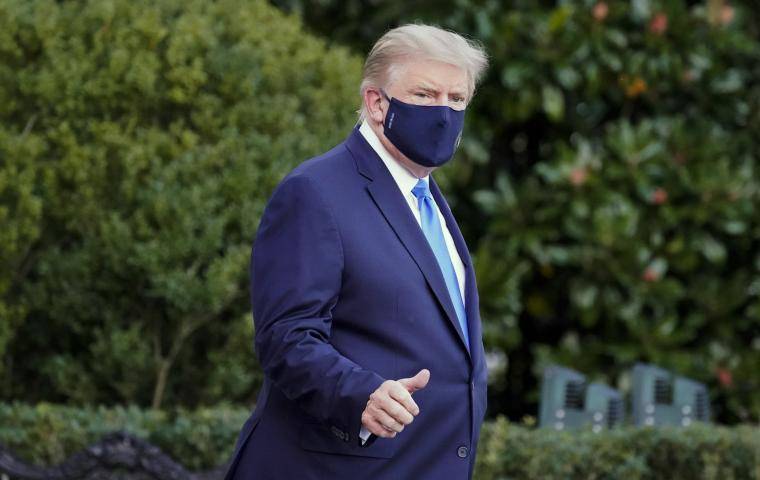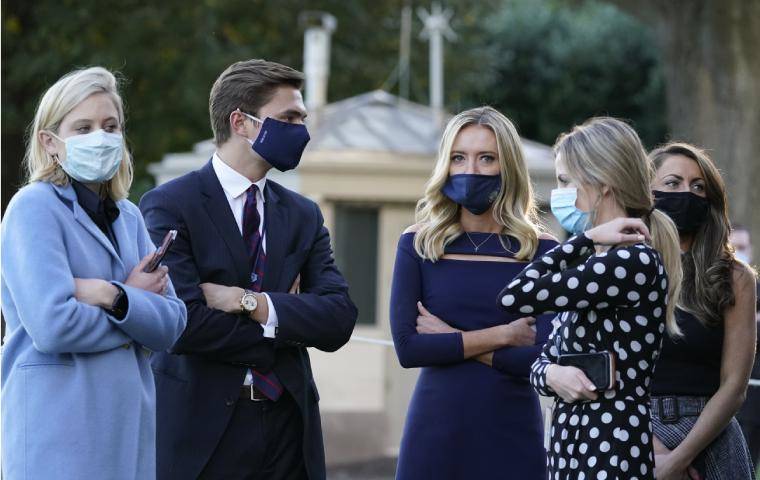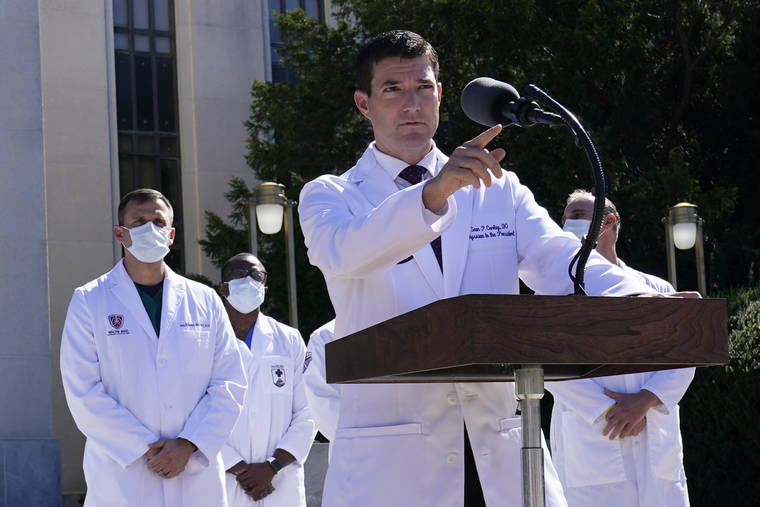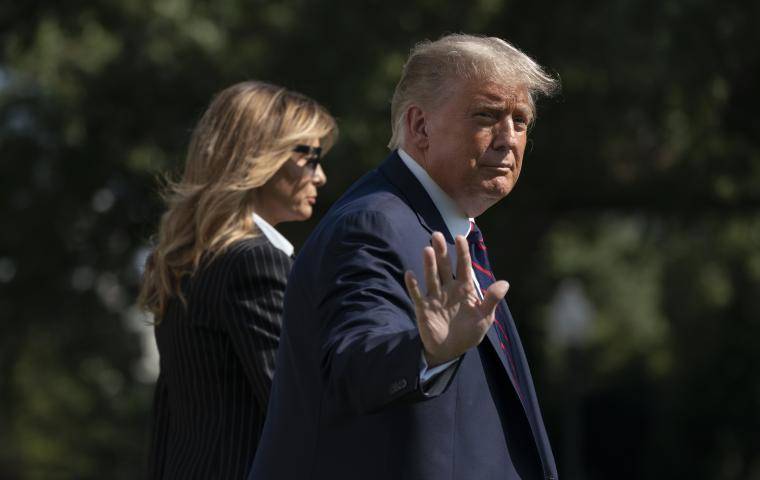Trump said to be improving but next 48 hours ‘critical’


ASSOCIATED PRESS
President Donald Trump left the White House, Friday, to go to Walter Reed National Military Medical Center after he tested positive for COVID-19, in Washington.

ASSOCIATED PRESS
President Donald Trump arrived at Walter Reed National Military Medical Center, in Bethesda, Md., Friday, on Marine One helicopter after he tested positive for COVID-19. White House chief of staff Mark Meadows is at second from left.

ASSOCIATED PRESS
White House press secretary Kayleigh McEnany, third from left, waited with others as President Donald Trump prepared to leave the White House to go to Walter Reed National Military Medical Center after he tested positive for COVID-19, Friday, in Washington.

ASSOCIATED PRESS
Dr. Sean Conley, physician to President Donald Trump, briefs reporters at Walter Reed National Military Medical Center in Bethesda, Md., today. Trump was admitted to the hospital after contracting the coronavirus.

ASSOCIATED PRESS
President Donald Trump and first lady Melania Trump walked to board Marine One at the White House, Tuesday, in Washington, for the short trip to Andrews Air Force Base en route to Cleveland for first debate against Democrat Joe Biden.

ASSOCIATED PRESS / SEPT. 29
President Donald Trump stands on stage with first lady Melania Trump after the first presidential debate with Democratic presidential candidate former Vice President Joe Biden at Case Western University and Cleveland Clinic, in Cleveland, Ohio, on Tuesday.







BETHESDA, MD. >> President Donald Trump went through a “very concerning” period Friday and faces a “critical” next two days in his fight against COVID-19 at a military hospital, his chief of staff said today — in contrast to a rosier assessment moments earlier by Trump doctors, who took pains not to reveal the president had received supplemental oxygen at the White House before his hospital admission.
Trump offered his own assessment today evening in a video from Walter Reed National Military Medical Center, saying he was beginning to feel better and hoped to “be back soon.”
— Donald J. Trump (@realDonaldTrump) October 3, 2020
Don't miss out on what's happening!
Stay in touch with breaking news, as it happens, conveniently in your email inbox. It's FREE!
Hours earlier, chief of staff Mark Meadows told reporters outside the hospital, “We’re still not on a clear path yet to a full recovery.” In an update on the president Saturday night, his chief doctor expressed cautious optimism but added that the president was “not yet out of the woods.”
The changing, and at times contradictory, accounts created a credibility crisis for the White House at a crucial moment, with the president’s health and the nation’s leadership on the line. With Trump expected to remain hospitalized several more days and the presidential election looming, his condition is being anxiously watched by Americans.
Moreover, the president’s health represents a national security issue of paramount importance not only to the functions of the U.S. government but to countries around the world, friendly and otherwise.
Saturday’s briefing by Navy Commander Dr. Sean Conley and other doctors raised more questions than it answered. Conley repeatedly refused to say whether the president ever needed supplemental oxygen, despite repeated questioning, and declined to share key details including how high a fever Trump had been running before it came back down to a normal range. Conley also revealed that Trump had begun exhibiting “clinical indications” of COVID-19 on Thursday afternoon, earlier than previously known.
Conley spent much of the briefing dodging reporters’ questions, as he was pressed for details.
“Thursday no oxygen. None at this moment. And yesterday with the team, while we were all here, he was not on oxygen,” Conley said.
But according to a person familiar with Trump’s condition, Trump was administered oxygen at the White House on Friday morning, well before he was transported to the military hospital by helicopter that evening. The person was not authorized to speak publicly and spoke to The Associated Press only on condition of anonymity,
Conley said that Trump’s symptoms, including a mild cough, nasal congestion and fatigue “are now resolving and improving,” and said the president had been fever-free for 24 hours. But Trump also is taking aspirin, which lowers body temperature and could mask or mitigate that symptom.
“He’s in exceptionally good spirits,” said another doctor, Sean Dooley, who said Trump’s heart, kidney, and liver functions were normal and that he was not having trouble breathing or walking around.
In an evening health update, Conley said Trump had been up and moving around his medical suite without difficulty and conducting business. “While not yet out of the woods, the team remains cautiously optimistic,” he said.
In the hospital video, Trump defended his decision to continue campaigning and holding large events in the midst of a pandemic.
“I had no choice,” said Trump, who refused to abide by basic public health recommendations, including mask-wearing. “I had to be out front … I can’t be locked up in a room upstairs and totally safe. … As a leader, you have to confront problems.”
Trump also thanked his medical team and hailed the state-of-the-art treatments he was receiving, comparing them to “miracles coming down from God.” Trump’s medical care is far superior to the average American’s, with around-the-clock attention and experimental treatments.
The president was angry at Meadows’ public assessment of his health and, in an effort to prove his vitality, Trump ordered up the video and authorized longtime confidant Rudy Giuliani to release a statement on his behalf that he was feeling well, according to a Republican close to the White House not authorized to publicly discuss private conversations.
Trump is 74 years old and clinically obese, putting him at higher risk of serious complications from a virus that has infected more than 7 million people nationwide and killed more than 200,000 people in the U.S.
First lady Melania Trump remained at the White House to recover from her own bout with the virus. She was “really handling it very nicely,” Trump said in the video, noting with a touch of humor that she was “just a little tiny bit younger” — in fact, 24 years younger.
Meadows himself had insisted Friday morning that Trump had only “mild symptoms” as the White House tried to project an image of normalcy. It was unclear whether Trump already had received oxygen when Meadows spoke.
“President Trump remains in good spirits, has mild symptoms and has been working throughout the day,” press secretary Kayleigh McEnany said late in the day on Friday. She said Trump had only been sent to Walter Reed as a precaution.
Trump’s administration has been less than transparent with the public throughout the pandemic, both about the president’s health and the virus’ spread inside the White House. The first word that a close aide to Trump had been infected came from the media, not the White House. And aides have repeatedly declined to share basic health information, including a full accounting of the president’s symptoms, what tests he’s undertaken and the results.
In a memo released late Friday, Conley did report that Trump had been treated at the hospital with remdesivir, an antiviral medication, after sharing that he’d taking another experimental drug at the White House.
Conley declined to say when Trump had last been tested before he was confirmed to have COVID-19 late Thursday. He initially suggested that Trump was 72 hours into the diagnosis — which would mean that he was confirmed infected Wednesday. Conley later clarified that Trump was administered an accurate test for the virus on Thursday afternoon, after White House aide Hope Hicks was confirmed to be positive and Trump exhibited “clinical indications” of the virus.
The White House has said Trump was expected to stay at the hospital for “a few days” and would continue to work from its presidential suite, which is equipped to allow him to keep up his official duties. In addition to accessibility to tests and equipment, the decision to move to the hospital on Friday was made, at least in part, with the understanding that hurrying there later could send a worrying signal if he took a turn for the worse.
On Saturday, Conley said Trump’s blood oxygen level was 96%, which is in the normal range. The two experimental drugs he has received, given through an IV, have shown some promise against COVID-19. On Friday, he was given a single dose of a drug Regeneron Pharmaceuticals Inc. is testing to supply antibodies to help his immune system fight the virus.
Friday night, he began a five-day course of remdesivir, a Gilead Sciences drug currently used for moderately and severely ill patients. The drugs work in different ways — the antibodies help the immune system rid the body of virus and remdesivir curbs the virus’ ability to multiply.
“We’re maximizing all aspects of his care,” attacking the virus in multiple ways, Conley said. “I didn’t want to hold anything back if there was any possibility it would add value to his care.”
He noted that in many cases, COVID-19 can become more dangerous as the body responds. “The first week of COVID, and in particular day seven to 10, are the most critical in determining the likely course of this illness,” he said.
At the same time, the White House has been working to trace a flurry of new infections of close Trump aides and allies. Attention is focused in particular on last Saturday’s White House event introducing Trump’s Supreme Court nominee. That day, Trump gathered more than 150 people in the Rose Garden, where they mingled, hugged and shook hands — overwhelmingly without masks. There were also several indoor receptions, where Trump’s Supreme Court pick, Judge Amy Coney Barrett, her family, senators and others spent time in the close quarters of the White House, photographs show.
Among those who attended and have now tested positive: former New Jersey Gov. Chris Christie, White House counselor Kellyanne Conway, the president of the University of Notre Dame, and at least two Republican lawmakers — Utah Sen. Mike Lee and North Carolina Sen. Thom Tillis. The president’s campaign manager, Bill Stepien, and the head of the Republican National Committee, Ronna McDaniel, have also tested positive, though they were not at the event.
Despite its failure to protect the president and senior staff from infection, the White House has given no indication that it intends to make any major protocol changes, such as mandating that everyone wears a mask.
Meadows, the chief of staff, accompanied the president to the hospital aboard Marine One, the kind of small, enclosed space where experts say the virus easily spreads. Those aboard did wear masks.
While Vice President Mike Pence is currently off the campaign trail preparing for the coming week’s vice presidential debate, he and his staff are operating under a “business as usual” approach. He’s still planning to travel to Arizona on Thursday, Indiana on Friday and Florida on Saturday for events instead of isolating himself after potential exposure and to protect himself from contracting the virus anywhere else.
PREVIOUS COVERAGE
BETHESDA, Md. >> President Donald Trump’s doctor today painted a rosy picture of the president’s health as he remains hospitalized for coronavirus treatment. But that assessment was immediately contradicted by a person familiar with Trump’s condition, who said the president was administered supplemental oxygen on Friday at the White House.
As well, Trump’s chief of staff, Mark Meadows, said the president went through a “very concerning” period Friday and the next 48 hours will be critical in terms of his care.
The briefing by Navy Commander Dr. Sean Conley and other doctors at Walter Reed Medical Center raised more questions than it answered, as the president’s physician left murky the issue of whether the president needed supplemental oxygen and declined to discuss exactly when he fell ill. Conley, in his briefing, also revealed that Trump began exhibiting “clinical indications” of COVID-19 on Thursday afternoon, earlier than known.
According to the person familiar with Trump’s condition, Trump was administered oxygen at the White House on Friday before he was transported to the military hospital. The person, who was not authorized to speak publicly and spoke to The Associated Press on condition of anonymity,
Conley had said Trump has been fever-free for 24 hours as he updated the nation on the president’s condition from Walter Reed this afternoon. Trump was admitted Friday after testing positive for the coronavirus and has been undergoing treatment.
While Conley said the president is not currently on oxygen, he refused to say whether the president had ever been on oxygen, despite repeated questioning.
“Thursday no oxygen. None at this moment. And yesterday with the team, while we were all here, he was not on oxygen,” he said. He said that Trump’s symptoms, including a cough and nasal congestion “are now resolving and improving.”
“He’s in exceptionally good spirits,” said another doctor, Sean Dooley.
>> PHOTOS: President Trump leaves White House for military hospital Opens in a new tab
The administration has been less than transparent about the president’s health as the virus spread inside the White House. Aides had declined to share basic health information about the president, including a full accounting of his symptoms, what tests he’s undertaken and the results. The first word that a close aide to Trump had been infected came from the media, not the White House.
In a memo released shortly before midnight, Conley did report that Trump had been treated at the hospital with remdesivir, an antiviral medication, after taking another experimental drug at the White House. He added that Trump is “doing very well” and is “not requiring any supplemental oxygen.”
Conley, the White House doctor, declined to say when Trump had last been tested before he was confirmed to have COVID-19 late Thursday. He initially suggested that Trump was 72 hours into the diagnosis, putting the confirmation of the infection to Wednesday.
Conley later clarified that Trump was administered an accurate test for the virus on Thursday afternoon, after White House aide Hope Hicks was confirmed to be positive and Trump exhibited unspecified “clinical indications” of the virus.
The White House said Trump was expected to stay at the hospital for “a few days” and he would continue to work from the hospital’s presidential suite, which is equipped to allow him to keep up his official duties. In addition to accessibility to tests and equipment, the decision was made, at least in part, with the understanding that moving him later, if he took a turn for the worse, could send a worrying signal.
Today, Conley said Trump’s blood oxygen level is 96%, which is in the normal range. Trump has been treated with two experimental drugs, given through an IV, that have shown some promise against COVID-19. On Friday, he was given a single dose of a drug Regeneron Pharmaceuticals Inc. is testing to supply antibodies to help his immune system fight the virus.
Friday night, he began a five-day course of remdesivir, a Gilead Sciences drug currently used for moderately and severely ill patients. The drugs work in different ways — the antibodies help the immune system rid the body of virus and remdesivir curbs the virus’ ability to multiply. “We’re maximizing all aspects of his care,” attacking the virus in multiple ways, Conley said. “I didn’t want to hold anything back if there was any possibility it would add value to his care.”
The White House said Trump was expected to stay at the hospital for “a few days” and he would continue to work from the hospital’s presidential suite, which is equipped to allow him to keep up his official duties. In addition to accessibility to tests and equipment, the decision was made, at least in part, with the understanding that moving him later, if he took a turn for the worse, could send a worrying signal.
As the White House works to piece together the flurry of new infections, attention is focused in particular on last Saturday’s White House event introducing Trump’s Supreme Court nominee. That day, Trump gathered more than 150 people in the Rose Garden. People mingled, hugged and shook hands — overwhelmingly without masks. There were also several indoor receptions, where Trump’s Supreme Court pick, Judge Amy Coney Barrett, her family, senators and others mingling in the close quarters of the White House, photographs show.
Among those who attended who have now tested positive: former White House counselor Kellyanne Conway, the president of the University of Notre Dame, and at least three Republican lawmakers Opens in a new tab, including Utah Sen. Mike Lee, and North Carolina Sen. Thom Tillis.
— Donald J. Trump (@realDonaldTrump) October 2, 2020
The decision for the president to leave the White House for the hospital capped a day of whipsaw events in Washington Friday. The president, who has spent months playing down the threat of the virus, was forced to cancel all campaign events a month before the election as he fought a virus that has killed more than 205,000 Americans and is hitting others in his orbit as well.
Trump walked out of the White House on Friday evening wearing a mask and gave a thumbs-up to reporters but did not speak before boarding Marine One. Members of the aircrew, Secret Service agents and White House staff wore face coverings to protect themselves from the president onboard the helicopter.
In a video taped before leaving for Walter Reed, Trump said, “I think I’m doing very well, but we’re going to make sure that things work out.” He remained fully president, all authority intact.
Going welI, I think! Thank you to all. LOVE!!!
— Donald J. Trump (@realDonaldTrump) October 3, 2020
“Going welI, I think! Thank you to all. LOVE!!!” he wrote in his first tweet from the hospital Friday night.
Trump first revealed that he had tested positive in a tweet just before 1 a.m. Friday — hours after he returned from a Thursday afternoon political fundraiser in New Jersey. He had gone ahead to the event, saying nothing to the crowd, even though he knew he had been exposed to an aide with the disease that has infected millions in America and killed more than 1 million people worldwide.
First lady Melania Trump also tested positive and has said she has mild symptoms. She is believed to be isolating at the White House.
Also testing positive: Trump’s campaign manager, Bill Stepien, who joined Trump at Tuesday’s first presidential debate, as well as former New Jersey Gov. Chris Christie, who helped him with debate prep. Today, Sen. Ron Johnson of Wisconsin became the third Senate Republican to publicly confirm testing positive in the current spate of infections, although Johnson was not at last week’s Rose Garden event.
Trump’s diagnosis came during an already turbulent period in Washington and around the world, with the U.S. gripped in a heated presidential election and the pandemic taking a heavy human and economic toll. Trump’s immediate campaign events were all canceled, and his next debate with Democrat Joe Biden, scheduled for Oct. 15, is now in question.
Trump has been trying all year — and as recently as Wednesday — to convince the American public that the worst of the pandemic is past, and he has consistently played down concerns about being personally vulnerable. He has mostly refused to abide by basic public health guidelines — including those issued by his own administration — such as wearing face coverings in public and practicing social distancing. Until he tested positive, he continued to hold campaign rallies that drew thousands of often maskless supporters.
“I felt no vulnerability whatsoever,” he told reporters back in May. With the election coming up in a month, he is urging states and cities to “reopen” and reduce or eliminate shutdown rules despite continuing virus outbreaks.
The White House tried to maintain an atmosphere of business-as-usual on Friday.
“President Trump remains in good spirts, has mild symptoms, and has been working throughout the day,” said press secretary Kayleigh McEnany. “Out of an abundance of caution, and at the recommendation of his physician and medical experts, the president will be working from the presidential offices at Walter Reed for the next few days.”
Trump received a dose of an experimental antibody combination by Regeneron that is in clinical trials, according to Conley, as well as remdesivir therapy, the antiviral medication.
“He has completed his first dose and is resting comfortably,” Conley wrote in his late Friday memo.
The first lady, who is 50, has a “mild cough and headache,” Conley reported, and the remainder of the first family, including the Trumps’ son Barron, who lives at the White House, has tested negative.
The first lady, who is 50, has a “mild cough and headache,” Conley reported, and the remainder of the first family, including the Trumps’ son Barron, who lives at the White House, tested negative.
Trump is 74 years old and clinically obese, putting him at higher risk of serious complications from a virus that has infected more than 7 million people nationwide.
Both Biden and his running mate Kamala Harris have tested negative, their campaign said. Vice President Mike Pence tested negative for the virus Friday morning and “remains in good health,” his spokesman said. Pence was to resume his campaign schedule after his test.
Barrett, who was with Trump and many others last Saturday and has been on a Capitol Hill meeting with lawmakers, also tested negative, the White House said. It was confirmed that she had a mild case of COVID earlier this year and has now recovered.
Many White House and senior administration officials were undergoing tests,, but the full scale of the outbreak around the president may not be known for some time as it can take days for an infection to be detectable by a test. Officials with the White House Medical Unit were tracing the president’s contacts.
Trump’s handling of the pandemic has already been a flashpoint in his race against Biden, who spent much of the summer off the campaign trail and at his home in Delaware, citing concern about the virus. Biden has since resumed a more active campaign schedule, but with small, socially distanced crowds. He also regularly wears a mask in public, something Trump mocked him for at Tuesday night’s debate.
“I don’t wear masks like him,” Trump said. “Every time you see him, he’s got a mask. He could be speaking 200 feet away from me, and he shows up with the biggest mask I’ve ever seen.”



